Hampden Watch Company, Springfield, MA, later Canton, OH
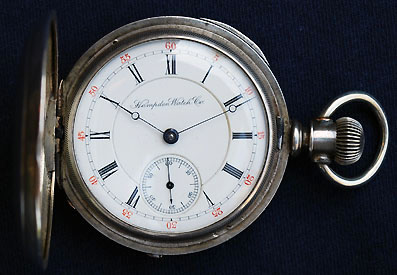 Mozart and New York Watch Companies
Mozart and New York Watch Companies
The Mozart Watch Company was originally organized by Don J Mozart and a group of investors in Providence, Rhode Island in 1864.
In October 1867 the Company reorganized as the New York Watch Company and moved to a one story brick plant in Springfield, MA. The company produced high and medium grade watches until the great financial panic of 1873 slowed production, with the factory closing in 1875.
The company was reorganized as the New York Watch Manufacturing Co. and resumed production, but again closed in the summer of 1876. One of the New York Watch Company's highest grades was the 18-size, 15-jewel Rail-Way grade, full plate movement, listed as adjusted to temperature.
Hampden Watch Company, Springfield, Mass
The Hampden Watch Company came into existence following a reorganization of the New York Watch Manufacturing Co. in January 1877. Homer Foote was the first President. The factory opened in the summer of 1877. By 1881 the company had expanded to five buildings with a capacity of 400 movements per day, and employed 400 workers.
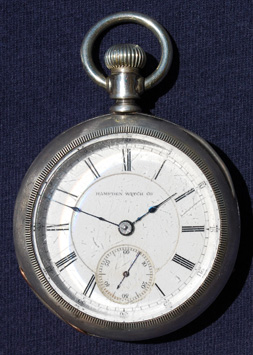 Hampden's highest listed 18-size grades were the 15-jewel Model 2 Railway grade, which was made almost entirely as a hunting case watch, and the Model 3 grade No. 60, which was the identically described and priced open face counterpart. The 18-size J.C. Perry grade was also 15-jewel, with a patent regulator and adjusted to temperature and positions. The Hampden Watch Company also introduced a 16-size 3/4 plate movement.
Hampden's highest listed 18-size grades were the 15-jewel Model 2 Railway grade, which was made almost entirely as a hunting case watch, and the Model 3 grade No. 60, which was the identically described and priced open face counterpart. The 18-size J.C. Perry grade was also 15-jewel, with a patent regulator and adjusted to temperature and positions. The Hampden Watch Company also introduced a 16-size 3/4 plate movement.
Hampden Watch Company, Canton, Ohio
In 1886 John C. Dueber's Dueber Watch Case Manufacturing Co. of Newport, Kentucky purchased a controlling interest in the Hampden Watch Co. In 1888-1889 both operations were moved to a pair of adjacent factory buildings in Canton, Ohio. The firm then began to advertise itself as the Dueber-Hampden Watch Co. Although the ads continued to use the Dueber-Hampden name, both companies remained two separate companies. In 1891 an open face 18-size Railway grade was introduced, replacing the No. 60 grade.
Although higher-jeweled watches had been available for decades, most high grade watches only had 15 jewels. Hampden was the first to mass produce and heavily promote 17-jewel watches. In 1891, Hampden created an advertising campaign for their new line of 17-jewel watches that lasted for years. The 18-size, 17-jewel Special Railway grade and 18-size, 17-jewel New Railway grade were part of the new group of watches introduced in the 1891 advertising campaign, both were advertised as adjusted to temperature and six positions, available as open face or hunting, and "particularly desirable and specially recommended to meet the requirements of the railway service." This line also included the Anchor grade (hunting or open face), No. 48 (hunting case) and No. 68 (open Face), all 17-jewel adjusted to temperature and positions. Also included were the John C. Dueber grade, No. 43 (hunting case) and No. 63 (open Face) 17-jewel adjusted to temperature1. The 18-size, 15-jewel Railway grade was discontinued with the introduction of the new 17-jewel line.
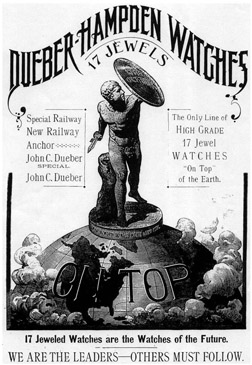 In pushing its line of 17-jewel watches, Hampden started a jewel count escalation that, over the next ten years, resulted in 21 and 23 jewel watches becoming commonplace. In 1896 an 18-size, 23-jewel Special Railway grade was introduced, and in 1900 an 18-size, 21-jewel Special Railway grade was introduced. Additional 18-size railroad grade movements included the 21-jewel John Hancock grade, adjusted to 5 positions, the 21-jewel North American Railway grade, adjusted to 5 positions, and the 21-jewel John C. Dueber grade, also adjusted to 5 positions.
In pushing its line of 17-jewel watches, Hampden started a jewel count escalation that, over the next ten years, resulted in 21 and 23 jewel watches becoming commonplace. In 1896 an 18-size, 23-jewel Special Railway grade was introduced, and in 1900 an 18-size, 21-jewel Special Railway grade was introduced. Additional 18-size railroad grade movements included the 21-jewel John Hancock grade, adjusted to 5 positions, the 21-jewel North American Railway grade, adjusted to 5 positions, and the 21-jewel John C. Dueber grade, also adjusted to 5 positions.
In July 1900 the Hampden Watch Company secured the trademark rights to the word "Railway" on a watch.
16-size Watches for Railroad Service
Popularity of 16-size movements increased after the establishment of railroad standards in 1892, reaching 15% of watch sales by the turn of the century. During the mid-1890's Hampden introduced the 16-size, 23-jewel, model 2 grade No. 104, one of the companies highest grade watches, available in both open face and hunting configurations. A 23-jewel, model 2 grade No. 105 was also released.
A thinner 16-size, 23-jewel, model 4 grade No. 104, was introduced in late 1902, along with the 21-jewel model 4 grade No. 105, the 21-jewel, model 2 Wm. McKinley grade, and the 19-jewel model 4 Railway grade. A 16-size, 23-jewel model 5 No. 105 grade was introduced around 1917. A 16-size, 23-jewel model 5 Special Railway grade was introduced around 1920.
The Dueber Watch Case Manufacturing Co. and Hampden Watch Co. businesses were formally combined 1923. Dueber-Hampden remained Dueber family owned until Albert M. Dueber, John Dueber's son, sold the business to a group of Cleveland, Ohio businessmen in September 1925.
The combined Dueber-Hampden operation continued in business, producing both movements and cases (and marketing them as complete watches) until falling sales led to receivership in 1927. The manufacturing equipment, parts on hand, and work in progress were sold to Russia. Operations ceased in 1930 when the machinery was shipped to Russia, the equipment is reported to have filled 28 freight cars.
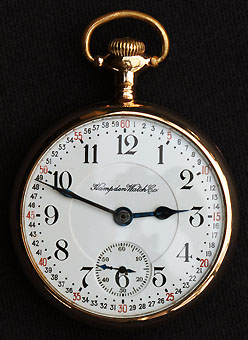 Hampden railroad grade watches (not all were railroad approved)
Hampden railroad grade watches (not all were railroad approved)
The following is from list of railroad grade watches which is generally attributed Webb C. Ball. Not all of these were railroad approved even though all were listed as railroad grade.
New York Watch Company Production Dates By Serial Number
Note: These are approximate dates, actual dates may vary by years. The serial number being referred to is the serial number on the movement of the watch, not the case. Some New York watch movements were apparently completed later by Hampden.
| 1866 - 1,000 | 1868 - 5,000 | 1870 - 10,000 | 1872 - 30,000 | 1874 - 50,000 |
| 1867 - 3,000 | 1869 - 7,000 | 1871 - 20,000 | 1873 - 40,000 | 1875 - 58,000 |
Hampden Production Dates by Serial Number
| 1877 - 59,000 | 1888 - 560,000 | 1899 - 1,255,000 | 1910 - 2,650,000 | 1921 - 3,700,000 |
| 1878 - 70,000 | 1889 - 640,000 | 1900 - 1,384,000 | 1911 - 2,700,000 | 1922 - 3,750,000 |
| 1879 - 100,000 | 1890 - 740,000 | 1901 - 1,512,000 | 1912 - 2,760,000 | 1923 - 3,800,000 |
| 1880 - 140,000 | 1891 - 805,000 | 1902 - 1,642,000 | 1913 - 2,850,000 | 1924 - 3,850,000 |
| 1881 - 180,000 | 1892 - 835,000 | 1903 - 1,768,000 | 1914 - 2,920,000 | 1925 - 3,900,000 |
| 1882 - 215,000 | 1893 - 835,000 | 1904 - 1,896,000 | 1915 - 3,000,000 | 1926 - 3,950,000 |
| 1883 - 250,000 | 1894 - 900,000 | 1905 - 2,024,000 | 1916 - 3,100,000 | 1927 - 3,980,000 |
| 1884 - 300,000 | 1895 - 930,000 | 1906 - 2,152,000 | 1917 - 3,240,000 | |
| 1885 - 350,000 | 1896 - 970,000 | 1907 - 2,280,000 | 1918 - 3,390,000 | |
| 1886 - 400,000 | 1897 - 1,000,000 | 1908 - 2,400,000 | 1919 - 3,500,000 | |
| 1887 - 480,000 | 1898 - 1,120,000 | 1909 - 2,520,000 | 1920 - 3,600,000 |
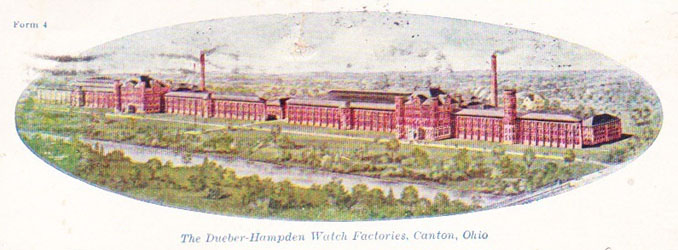
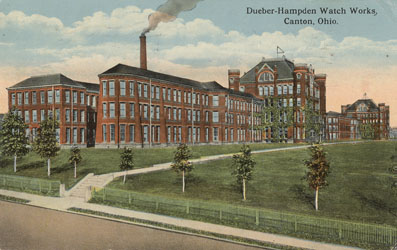
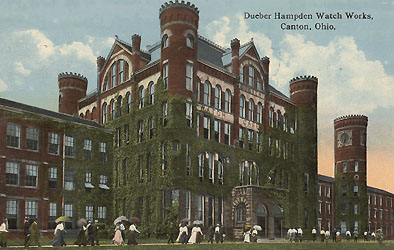
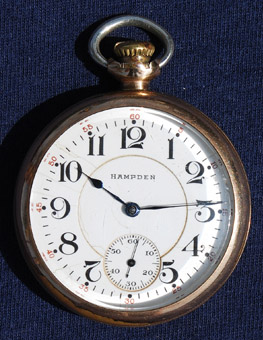 Links to other sites for additional information:
Links to other sites for additional information:
Pocket Watch Database: - Serial number lookup and information for Ball, Elgin, Hamilton, Hampden, Illinois, Rockford, South Bend and Waltham.
NAWCC Chapter 149 Hampden Watch Database - Serial number lookup and information for Hampden watches.
Additional Reading:
Abbott, Henry G. The Watch Factories of America Past and Present: A complete history of Watch Making in America, from 1809 to 1888 Inclusive. Geo. K Hazlitt & Co. Chicago, 1888, reprinted by Forgotten Books, Lexington, KY, 2012.
Gibbs, James W. The Dueber-Hampden Story. copyright 1954 National Association of Watch and Clock Collectors, Inc.
Ueberall, Ed and Singer, Kent, Dueber-Hampden's Special Railway. NAWCC Bulletin, October 2005, pp. 621-631.
1 By the early-1890's new watches entering railroad service were required to be adjusted to isochronism, temperature and position on a growing number of railroads that required watch inspection. In creating watch standards for the Lake Shore & Michigan Southern Railway Co. Webb C. Ball, Chief Inspector of Watches, on August 15, 1891 indicated the standard adopted by the Company for its employes' watches now in service is one is equal to what is generally known among American movements as the "15-jewels, Patent Regulator, adjusted." Ball indicated this quality of movement "is represented by the Elgin Raymond and No. 70, by the Waltham No. 35 and Crescent Street, by Hampden Perry and Railway, Nos 59 and 60, by the Howard 'Gilt Heat and Cold,' and all grades above those named." Other railroads, including the Illinois Central Railroad Co. in 1892 continued to accept "American movements as fifteen-jewel, patent regulator, adjusted to heat and cold, the variation of which must not exceed 30 seconds per week." By the mid-1890's 18-size, 17-jewel pocket watches adjusted to positions dominated sales for railroad service.
American Waltham Aurora Ball Columbus Elgin National Hamilton Hampden E.Howard Illinois Peoria Rockford South Bend Seth Thomas U.S.Marion U.S.Waltham
Sharing A Heritage Railroad History Train Technology Railroad Operation Railroad Time Museums & Heritage Railroads Railroads Today
